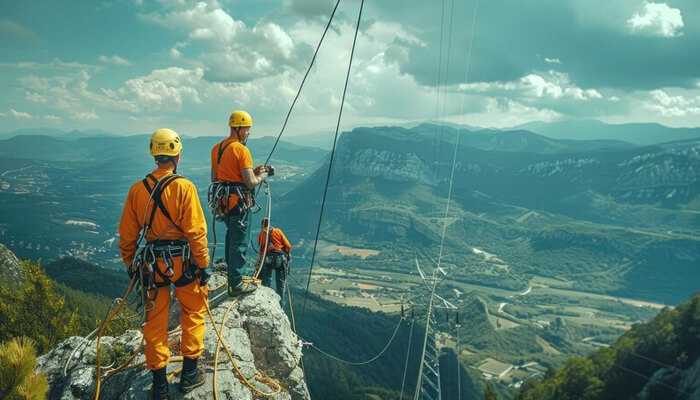Working in high altitude environments presents unique challenges and risks. Reduced oxygen levels, extreme weather conditions, and increased physical demands all contribute to a more hazardous working environment. Ensuring worker safety in these conditions requires proper training, preparation, and equipment. Below, we will explore the best practices for maintaining safety in high altitude environments, emphasizing how working at heights course can provide essential knowledge and skills for these demanding settings.
1. Comprehensive Training and Education
The most crucial elements of ensuring safety at height include proper training of personnel. The Operating at Heights training course assists personnel with essential information such as proper methods of using safety equipment, understanding physiological and psychological effects of working at extreme heights. These vary in the areas of fall protection to equipment use, risk evaluation, and mitigation technique development among other scenarios.
Training also ensures that workers are familiar with the specific hazards of high-altitude environments. These hazards can include lower oxygen levels, which can affect physical performance and cognitive function, and sudden weather changes, which may pose a danger if workers are unprepared. Workers gain the tools needed to handle these challenges safely by participating in a specialized course.
2. Proper Use of Safety Equipment in High Altitude Environments
Safety equipment is a must when working at heights. The basic workers should have are harnesses, safety ropes, helmets, and oxygen tanks. Properly fitted equipment is critical; poor fitting causes accidents. Workers are supposed to be trained in the checking of wear and tear of the equipment and carrying out proper functioning before use.
Working at heights course provides hands-on training in using such equipment, teaching workers the importance of regularly checking and maintaining their gear. Workers are shown how to correctly use fall protection systems and secure themselves in various environments. This minimizes the risk of equipment failure and accidents, ensuring workers stay safe while performing tasks at high altitudes.
3. Acclimatization and Monitoring of Health
One of the most difficult parts of working at high altitudes involves the low levels of oxygen that add to the altitude sickness. Symptoms are headaches, dizziness, and shortness of breath, among other more serious diseases such as pulmonary or brain edema. Acclimatization is very important in order to minimize these risks. The workers need to be gradually exposed to larger altitudes, and their bodies will become used to the lack of oxygen.
It is also very important to keep a constant check on one’s health. The workers must be screened for altitude sickness, and if the symptoms persist or crop up, they have to go down to lower altitudes and get medical help as and when required. Emphasis needs to be given to maintaining fitness and hydration levels since good levels of fitness will help the worker cope with the increased physical demands upon his body at high altitudes.
Training programs often include education on the symptoms of altitude sickness and the importance of acclimatization. Workers are encouraged to pace, stay hydrated, and communicate with supervisors if they feel unwell. This awareness helps prevent serious health issues and ensures workers can safely perform their duties.
4. Emergency Preparedness and Response in High Altitude Environments
These emergencies may happen anytime but are very frequent in high altitude environments where the meteorological condition alters very fast. Training in such instances is very important for job safety. Emergency response plans should be shared and rehearsed on a regular basis so that employees know exactly what to do when accidents happen or in cases of severe changes in weather conditions.
Working at heights course covers essential emergency response techniques, including how to respond in the case of falls, medical emergencies, or equipment failure. Workers are then trained on how to act in the occurrence of incidents immediately and calmly with the use of proper equipment and technique. Rescue equipment, such as ropes, stretchers, and first-aid kits, shall be readily available on site.
The other important aspect of preparing for emergencies is to establish channels of communication. Employees should be equipped with the necessary communication devices to ensure that an accident can be reported immediately to supervisors or the emergency services. As close to reality as possible training exercises on emergencies also offer the possibility to practice responses and find weak points in the safety plan.
5. Weather Awareness and Environmental Conditions
Weather conditions at high altitudes can be unpredictable and change rapidly. Sudden storms, high winds, and freezing temperatures can threaten workers. Therefore, regular weather monitoring is necessary before and during high-altitude work. Workers should be prepared for sudden changes by wearing appropriate clothing and having access to shelter if necessary.
Work will be delayed if the working conditions become too hazardous. Managers should never compromise on the safety of the workers for the sake of project schedules and should be in a position to halt work if bad weather is going to imperil the crew. Training programs like working at heights training teach the employees how to recognize hazardous weather conditions and how to take necessary precautions.
Besides, proper attire is required for such an environment. Workers in such conditions should be dressed in layers that can easily change when temperature fluctuates and have PPE such as gloves, goggles, and helmets which are made to stand the temperatures.
Conclusion
Working in high-altitude areas presents risks; however, this can easily be minimized following the best practices in the workplace. Naturally, proper training is necessary in teaching the employees how to use the safety equipment properly, maintain their health, and respond to situations that may arise. Acclimatization per se, coupled with good weather awareness ensures that a robust safety culture allows all workers to comfortably and efficiently execute their duties at altitudes considered high. Preparation and proactive commitment to safety are ways that could go a long way in preventing accidents and health issues, thus making the working conditions safer for all people.




